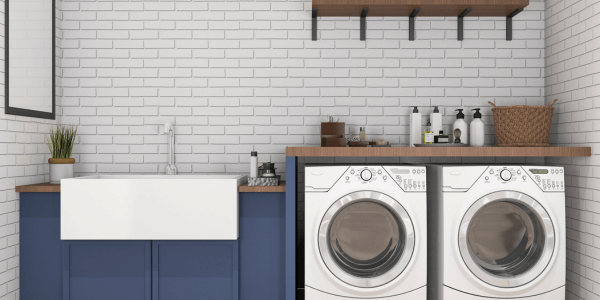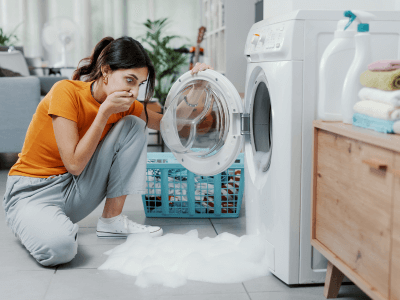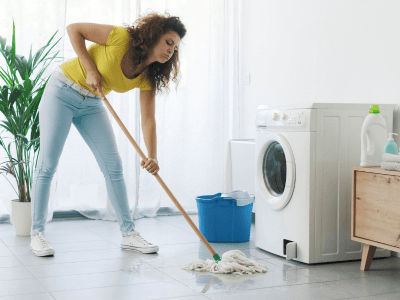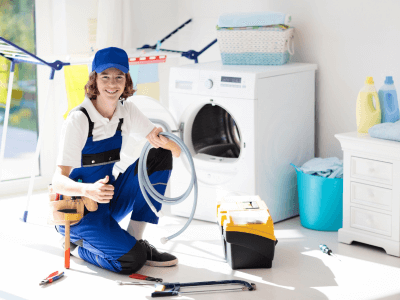

Your laundry room might not be the most glamorous part of your home, but when something goes wrong, it can suddenly feel like the center of your world. From piles of wet clothes to warped floors and soggy drywall, laundry room water damage can quickly turn into a nightmare. It’s a space we rely on constantly, yet we often overlook its maintenance—until disaster strikes.
Water damage can be costly, with repairs ranging from a few hundred dollars to several thousand, depending on the extent. But the good news? You can avoid many of these issues with a little foresight and preventive care. Let’s dive into how you can keep your laundry room dry and disaster-free.
The Top Culprits of Laundry Room Water Damage
Preventing pricey repairs starts with knowing how the problem happens in the first place. Here are the usual suspects:
- -Washing Machines
Causes: Overloading, unbalanced machines, clogged drain lines, overflowing during filling, and aging components can all lead to water damage.
Overflow Issue: If your washing machine overflows when filling, the water level sensor has malfunctioned, or the drain line is blocked. Regularly inspect your machine to ensure it’s functioning properly, and clear any blockages to prevent overflow-related flooding.
Bonus Tip: Consider upgrading to washing machines with built-in leak detection technology like an overflow sensor or automatic shutoff features to prevent overloading. Brands like GE Appliances and LG offer high-quality, water-efficient machines.
- -Leaking Hoses and Water Supply Lines
Causes: Corrosion, cracks, and general wear and tear over time can result in leaking hoses or faulty water supply lines.
Action Step: One of the easiest ways to protect against this is by installing steel-braided hoses. These are far more durable than traditional rubber hoses and are less likely to crack or burst. Don’t forget to check your connections every six months!
- -Poorly Maintained Sinks and Pipes
Causes: Loose connections, clogs, and corroding pipes are often overlooked but can cause significant water damage when neglected.
Pro Tip: DIY maintenance is easier than you might think! Regularly clean your sink’s drain with a simple mix of baking soda and vinegar, and ensure connections are tight and rust-free. Check out our detailed sink maintenance guide to avoid plumbing issues before they escalate.
- -Water Heaters (if it applies to your room setup)
Causes: Old anodes, cracked hoses, and rusted tanks can leak without warning, especially if your water heater is tucked away in the laundry room.
Advanced Tip: Set a regular maintenance schedule for your water heater. A simple annual checkup can extend the life of the unit and prevent leaks. Don’t forget to flush your tank to remove sediment buildup!
12 Proactive Steps to Avoid Laundry Room Water Damage

1. Know Where Your Shutoff Valve Is—and How to Use It: Don’t wait for an emergency to locate your water shutoff valve! Learn where it is and how to turn it off in case of leaks. Watch this quick video from San Antonio Water System for step-by-step instructions.
2. Inspect Hoses and Pipes Regularly: Worn or cracked hoses are one of the most common sources of water damage. Replace rubber hoses with steel-braided hoses every 5 years, and check them regularly for signs of wear.
3. Use a Drain Pan with an Automatic Shutoff Feature: A smart drain pan can detect leaks and shut off the water supply automatically, saving you from major water damage before you even notice something’s wrong.
4. Install Smart Water Sensors: Consider installing smart water leak detectors that alert you via phone if moisture is detected. Brands like Honeywell and Flume offer reliable options that can give you peace of mind (another great affiliate link opportunity!).
5. Upgrade to Water Leak-Proof Hoses: Leak-proof hoses are designed to withstand higher pressures and reduce the risk of cracks and bursts. They’re a bit more expensive upfront, but the longevity and security they provide are worth the investment.
6. Don’t Overload Your Washing Machine: Avoid stress on your washing machine’s components by not overloading it. Too much weight causes imbalances, which can lead to leaks or damage to surrounding fixtures.
7. Ensure Proper Washer Placement and Stability: An unbalanced washing machine can move during operation and damage nearby plumbing or walls. Make sure your washer is level and secure.
8. Clean Your Utility Sink’s Drain Regularly: A clogged utility sink can lead to overflow. Keep the drain clear with regular maintenance—use a drain snake or a simple vinegar and baking soda solution to keep it running smoothly.
9. Install a Water Heater Expansion Tank (If Applicable): If your water heater is in the laundry room, installing an expansion tank helps absorb excess pressure that could otherwise cause leaks or bursts.
10. Upgrade to a Washing Machine Pan with a Drain: A pan under your washing machine can contain small leaks and drain them away from your floors, preventing significant damage.
11. Consider Adding a Dehumidifier: Excess moisture in the laundry room can lead to mold and mildew over time. Adding a dehumidifier helps control humidity levels, especially in humid climates.
12. Be Present When Doing Laundry: It may seem simple, but staying home while doing laundry can prevent disasters. If something goes wrong, you can catch it early and stop a small leak from turning into a flood.
How to Identify Early Signs of Laundry Room Water Damage
Here’s a quick checklist to help you spot early signs of water damage:
- –Water stains or discoloration on walls or floors.
- –Warping of hardwood or laminate flooring.
- –Musty or damp smells in the laundry area.
- -Rust or corrosion around plumbing fixtures.
- -Visible mold or mildew growth.
We recommend inspecting your laundry room every 3 months for these warning signs to stay ahead of any issues.
FAQ

How often should I replace my washer’s hoses?
It’s a good idea to replace your washer’s hoses every 5 years, even if they look fine. Opt for steel-braided hoses for added durability.
What’s the best way to clean a clogged sink drain?
Start with a mix of baking soda and vinegar, followed by hot water. For tougher clogs, a drain snake or a plunger works wonders.
What do you do if your laundry room is flooded?
First, turn off the water supply and electricity to the area. Use towels or a wet/dry vacuum to remove standing water, and contact a professional like Complete Flood Restoration for help.
Why are my laundry room walls wet?
Wet walls could indicate a hidden leak or excess humidity. Check for leaking hoses or pipes, and consider using a dehumidifier to reduce moisture levels.
How do I get moisture out of my laundry room?
A dehumidifier is your best friend. Also, ensure proper ventilation and fix any leaks or plumbing issues to keep moisture levels down.
Why is my laundry room floor wet?
A wet floor could be caused by a leaking washing machine, clogged sink, or faulty hoses. Inspect your hoses, pipes, and washing machine for leaks, and make sure your drain is clear.
Don’t Wait for a Laundry Room Disaster—Take Action Now
A little bit of maintenance can save you from a big, expensive mess. Regular inspections, smart upgrades, and staying proactive can make all the difference in preventing water damage. Don’t wait for disaster to strike—take action today to protect your laundry room.
Need a professional inspection or help with repairs? Contact Complete Flood Restoration now for expert advice and services that keep your home dry and damage-free!
